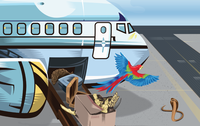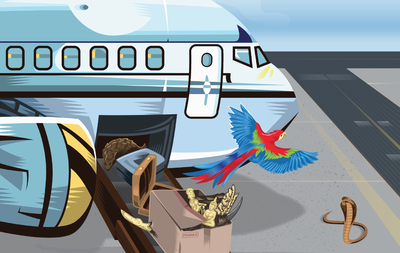Wildlife Traffickers Exploiting Vulnerabilities in the Air Transport Sector Worldwide
Aug 06, 2018
WASHINGTON, 6 August 2018 — A new analysis of global wildlife trafficking seizures in the air transport sector reveals that wildlife traffickers are highly dependent on commercial air transportation systems to smuggle endangered wildlife.
The report, In Plane Sight: Wildlife Trafficking in the Air Transport Sector, produced by C4ADS as part of the USAID Reducing Opportunities for Unlawful Transport of Endangered Species (ROUTES) Partnership, analyzes global airport seizures of illegal wildlife and wildlife products from 2009 to 2017, finding trafficking instances in more than 130 countries worldwide. New data from 2017 shows a massive spike in rhino horns seizures, which nearly tripled from 2016 numbers.
The seizure data indicate that wildlife traffickers moving ivory, rhino horn, reptiles, birds, pangolins, marine products, and mammals by air tend to rely on large hub airports all over the world. Collectively, these categories account for about 81 percent of all trafficked wildlife, according to the United Nations Office on Drugs and Crime (UNODC), and serve as indicators for broader trends within illicit wildlife trafficking.
According to the In Plane Sight report, routes of wildlife products such as ivory, rhino horn and pangolin tend to flow from Africa to Asia, often transiting first through the Middle East and Europe. Wildlife traffickers carrying live animals, such as live birds and reptiles, generally rely on direct flights worldwide with different hotspots for wildlife trafficking in every region. China was by far the most common destination for all seized wildlife products between 2009 and 2017.
“Wildlife trafficking has global implications for the environment, people and communities, and national security. Seizure data like this is vital to helping regulators, enforcement, and industry take action,” said TRAFFIC’s Michelle Owen, the ROUTES Partnership Lead. “Criminals involved in wildlife trafficking 
In Plane Sight outlines more than a dozen recommendations based on seizure data for preventing wildlife trafficking through the air transport sector. These include building awareness among personnel and passengers, training air industry staff, strengthening corporate policies and seizure protocols, and sharing seizure information.
“Many airlines recognize the need to combat wildlife trafficking and are stepping up as leaders in this global effort. Airline staff spend more time with passengers and baggage than customs authorities and can provide a key source of intelligence for enforcement agencies,” said Jon Godson, Assistant Director of Environment at the International Air Transport Association (IATA).
“Traffickers are increasingly abusing transport systems to move their products quickly and securely. During the journey from source to market, airports may be used in the transit,” said Juliana Scavuzzi, Senior Manager of Environment at Airports Council International (ACI) World. “This provides airports with an important opportunity to play their role in preventing wildlife trafficking. ACI is committed to developing a framework to fight wildlife trafficking, and support our members with their efforts.”
In Plane Sight is the most comprehensive assessment of wildlife trafficking in the air transport sector to date, and builds on the previous ROUTES report, Flying Under the Radar, which was released in 2017 and focused on seizures of rhino horn, ivory, live birds and live reptiles from 2009-2016. By including 2017 data and assessing trafficking incidents of pangolin, marine products, and mammal products, In Plane Sight provides a more in-depth look at wildlife trafficking methods and trends around the world.
“Wildlife seizure data is vital for identifying, understanding and combatting wildlife trafficking in airports around the world,” said author Mary Utermohlen from C4ADS. “Still, it’s important to recognize that seizure data of any kind only provides a partial window into the true nature of trafficking activity. What seizures can’t show are the patterns and routes associated with trafficking activity that is not detected, seized or reported by enforcement authorities.”
The illegal trade of wildlife is the fourth largest black market in the world—worth in the region of $20 billion USD annually—and impacts more than 7,000 species of animals and plants. Criminal organizations involved in wildlife trafficking are often directly connected to other trafficking networks, with the profits being used for all manner of illegal activities.
###
ROUTES and the authors of In Plane Sight, Mary Utermohlen and Patrick Bain of C4ADS, will be hosting an online presentation and Q&A for members of the media and air transport sector.
RSVP to the August 8th webinar (10am-11am EDT) here
RSVP to the September 5th webinar (7am-8am EDT) here
FOR MORE INFORMATION:
Photos/infographics for press use
About ROUTES
The USAID Reducing Opportunities for Unlawful Transport of Endangered Species (ROUTES) Partnership brings together government agencies, transportation and logistics industry companies and representatives, international conservation, development and law enforcement organizations and donors in order to disrupt wildlife trafficking activities, and forms a key element of the concerted international response to addressing wildlife poaching and associated criminal activities worldwide.
At the heart of ROUTES is a core group of partners collaborating with the U.S. Government and the transport sector that includes the Center for Advanced Defense Studies (C4ADS), Freeland, the International Air Transport Association (IATA), TRAFFIC and WWF. The Partnership is funded by USAID and coordinated by TRAFFIC. To learn more, visit routespartnership.org or follow @ROUTESPartners
About USAID
The United States Agency for International Development (USAID) is responsible for the majority of overseas development assistance from the United States Government and leads international development and humanitarian efforts to save lives, reduce poverty, strengthen democratic governance and help people on their journey to self-reliance. For more information please visit usaid.gov or follow @USAID on Facebook and Twitter.
About C4ADS
C4ADS is a nonprofit organization dedicated to providing data-driven analysis and evidence-based reporting on global conflict and transnational security issues.
We use cutting-edge technologies to manage, integrate, and analyze disparate data from diverse languages, regions, and sources, incorporating our own field research from conflict zones and fragile states. We seek to engage with local and international audiences and produce compelling analysis on conflict and security issues. In doing so, we fill a critical gap left by traditional public sector and profit-driven institutions. For more information, visit c4ads.org or follow @C4ADS
About TRAFFIC
TRAFFIC, the wildlife trade monitoring network, is the leading non-governmental organization working globally on trade in wild animals and plants in the context of both biodiversity conservation and sustainable development. For more information, visit traffic.org or follow @TRAFFIC_WLTrade
About IATA
The International Air Transport Association (IATA) is the trade association for the world’s airlines, representing some 290 airlines or 82% of total air traffic. IATA supports many areas of aviation activity and helps formulate industry policy on critical aviation issues. For more information, visit IATA.org or follow@IATA2press
About ACI
Airports Council International (ACI), the trade association of the world’s airports, was founded in 1991 with the objective of fostering cooperation among its member airports and other partners in world aviation, including the International Civil Aviation Organization, the International Air Transport Association and the Civil Air Navigation Services Organisation. In representing the best interests of airports during key phases of policy development, ACI makes a significant contribution toward ensuring the global air transport system is safe, secure, efficient and environmentally sustainable. As of January 2018, provisional figures show that ACI serves 641 members operating 1,953 airports in 176 countries. For more information, visit aci.aero or follow @ACIWorld. For more information, visit aci.aero or follow @ACIWorld


